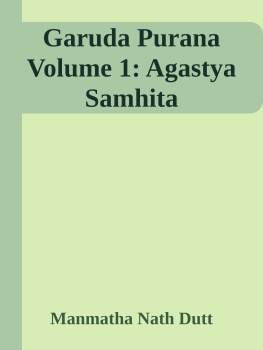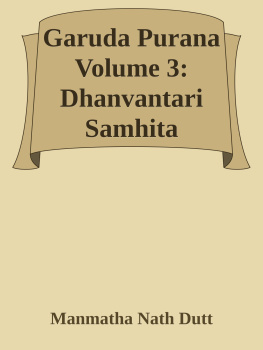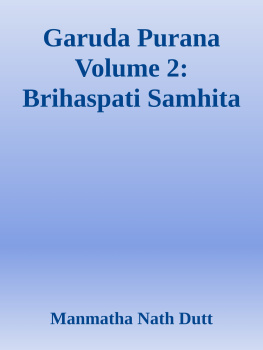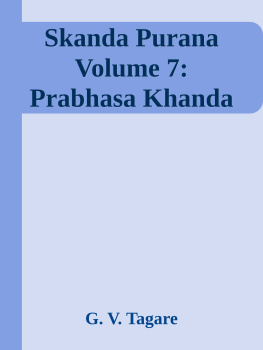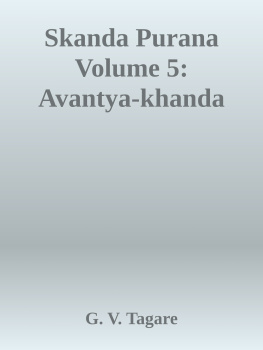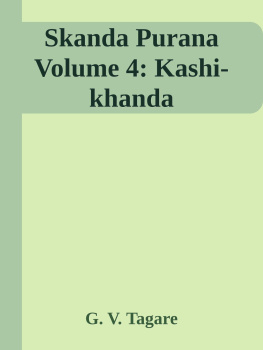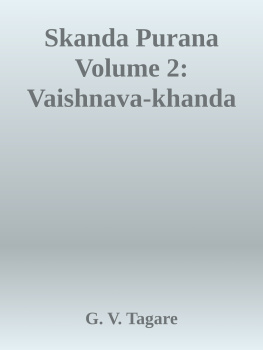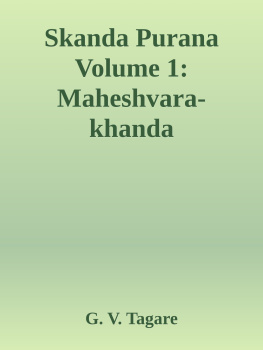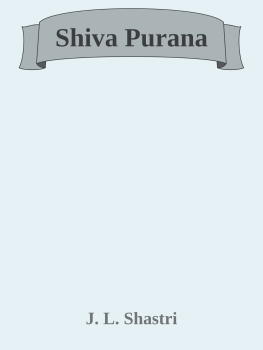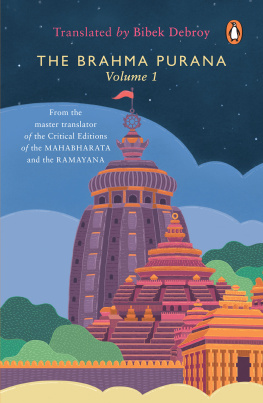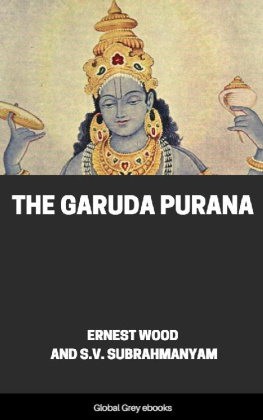Manmatha Nath Dutt - Garuda Purana Volume 1: Agastya Samhita
Here you can read online Manmatha Nath Dutt - Garuda Purana Volume 1: Agastya Samhita full text of the book (entire story) in english for free. Download pdf and epub, get meaning, cover and reviews about this ebook. genre: Religion. Description of the work, (preface) as well as reviews are available. Best literature library LitArk.com created for fans of good reading and offers a wide selection of genres:
Romance novel
Science fiction
Adventure
Detective
Science
History
Home and family
Prose
Art
Politics
Computer
Non-fiction
Religion
Business
Children
Humor
Choose a favorite category and find really read worthwhile books. Enjoy immersion in the world of imagination, feel the emotions of the characters or learn something new for yourself, make an fascinating discovery.
- Book:Garuda Purana Volume 1: Agastya Samhita
- Author:
- Genre:
- Rating:5 / 5
- Favourites:Add to favourites
- Your mark:
- 100
- 1
- 2
- 3
- 4
- 5
Garuda Purana Volume 1: Agastya Samhita: summary, description and annotation
We offer to read an annotation, description, summary or preface (depends on what the author of the book "Garuda Purana Volume 1: Agastya Samhita" wrote himself). If you haven't found the necessary information about the book — write in the comments, we will try to find it.
Garuda Purana Volume 1: Agastya Samhita — read online for free the complete book (whole text) full work
Below is the text of the book, divided by pages. System saving the place of the last page read, allows you to conveniently read the book "Garuda Purana Volume 1: Agastya Samhita" online for free, without having to search again every time where you left off. Put a bookmark, and you can go to the page where you finished reading at any time.
Font size:
Interval:
Bookmark:
EDITED AND PUBLISHED BY
Rector, Keshub Academy,
Author of the English Translations of the Ramayanam,
Bharatam, Srimadbhagavatam, Mahanirvana-Tantram,
Harivasha, Puranam,
Puranam, &c., &c.
INDIAN LITERATURE.
A few preliminary remarks on the history, scope and contents of the , etc., the Garuda Puranam, like its sister work, reflects but the knowledge of the Brahmanical world at the time, and had its uses then as it has even now.
Without doing violence to the antiquarian instinct, we must say that it is quite futile to attempt to lay down the precise date of the composition of the Garuda Puranam. Its name occurs in the and the Vedic literature. Thus each schism or faction, or more correctly, each Puranam, the scripture of each sect of special, tutelary divinities, became a new school of law, medicine and metaphysics, etc., re-instating the old errors of the Vedic literature, as if to ignore the many advanced truths and principles of the later day Buddhistic science, and to confirm the victory of Brahmanism even in error and fallacy.
The description of the incidents of the life of (Institutes of Vishnu) following the orthodox (Vedic) non-medical opinion on the subject gives it as three hundred and sixty-six.
We know that Nagarjuna, the Buddhist redactor of the Sushruta Samhita, mentioned in his recension of the work that there are three hundred bones in the human organism, but the followers of the Vedas say that their number is three hundred and sixty which tallies with the number given in the so as to be fully convinced of the truth of their statement, and attempted to make the Vedic number of skeletal bones as near to the truth as possible. This fact serves to throw a new light upon the date of the composition of the Garuda Puranam. It unmistakably points to a period of history when the victorious Brahmanism once more attempted to restore the teachings of the Vedas in their pristine glory, and the truths of the Buddhistic science or metaphysics.were still too potent a factor to be ignored or lightly dismisseda fact which supports our contention and lends a plausible colour to the view we have adopted as regards the probable date of the composition of the Garuda.
The second question, that confronts us, is the purity of the text, i.e., whether the Garuda Puranam, as we now possess it, is what it was originally written by its author; or whether its bulk has been considerably increased by subsequent additions? In the first Chapter we learn that, the Puranam consists of eight thousand and eight hundred verses, and the subjects dealt with therein are creation of the universe, , etc., and the insertion of a more detailed and elaborate dissertation on the subject under the style of Preta-Khanda is an unnecessary repetition and re-opening of a finished discourse (Samapta Punarattata) which is bad both in reason and rhetoric. We have attempted to expunge all spurious portions, or passages of questionable authenticity from the text in the light of the reasons stated above, and tried to restore it to its original form as far as possible after the progress of so many centuries since it first saw the light.
We may be asked the rationale of our conduct in undertaking the English translation of the Garuda Puranam. The question is natural enough, if the work is nothing but a compendium of Brahmanic rituals and mysteries, what is the profit of disinterring it from beneath the oblivion which it so unqualifiedly deserves. Our answer is that, in addition to the many mystic rites and practices, which legitimately fall within the range of studies in spiritualism, the Garuda Puranam contains three , and we are confident that any labour he may bestow on the subject in connection with the Agastya Samhita will be remunerated a hundred-fold.
The next Samhita in the Garuda Puranam is the Brihaspati Samhita, commonly known as the Nitisara, in which we find observations on practical conduct and a knowledge of human nature, which strongly remind one of Bacons essays and in comparision with which the Samhita gains one or two points more, not to speak of its excellent poetry and harmony. In the tiological portion of the Dhanvantari Samhita, one is astonished to find that in certain types of fever the blood undergoes a sort of chemical change which produces the morbific factors of the disease, that in hmoptisis the blood comes from the spleen, liver or the blood-vessels (facts unknown to the Nidanist, ), that there is a kind of parasites that produces leprosy, and cutaneous affections in general, facts which, it was but yesterday, that the science of the west have gained access to. The therapeutical portion of the Samhita contains many excellent remedies which can not but benefit man in the art of living a long, healthy life. It is almost impossible for us to give within such a small compass even the faintest glimpse of the splendid truths that lie scattered through the pages of this noble Puranam; enough if we conclude our remark with the saying that, it broadens the vision of a man into regions where systems and worlds are but bubbles and atoms, and enables him to consolidate his amity with those profound realities, which encompass being and becoming in every plane of existence, or at least helps him to lift up the veil of the Natures workshop and to catch a view, however slight and momentary, of the nature and essence of things.
CALCUTTA,
The 12th June, 1908.
M. N. DUTT.
and others, dwelling in the forest of Naimishi, having asceticism for their wealth, of quiescent souls, effulgent like the sun and ever engaged in the celebration of. sacrifices, said.
The Rishis said:O Suta, thou art informed of every thing and therefore we ask you Amongst the celestials .
SUTA said:I will describe the consisting of eight thousand and eight hundred verses Vyasa formerly narrated to me.
:
Inspired seers. A Siddha is a semi-divine being supposed to be of great purity and holiness characterised by Siddhis or eight supernatural faculties or perfections.
:
It is a system of philosophy ascribed to Kapila. It is called Sankhya because it enumerates twenty-five Tattvas or principles. According to this system final liberation is obtained by a true knowledge of these principles.
The .
The . Having bowed unto him I took my seat and accosted that foremost of ascetics saying:
O Vyasa, relate unto me the form of from which has emanated the creation of the universe. Methinks, while thou dost meditate on the Lord, thou must be knowing it.
, what he did relate on being thus accosted by me.
Vyasa said:Hear, O Suta, I will recount the and others.
The Suta said:How did Brahma relate the sacred Purana , describing the true essence, unto thee when united with Daksha, Narada and others.
Vyasa said:Having saluted Brahma who was residing in the and others said to him. Describe unto us the quintessence (of the sacred lore).
Font size:
Interval:
Bookmark:
Similar books «Garuda Purana Volume 1: Agastya Samhita»
Look at similar books to Garuda Purana Volume 1: Agastya Samhita. We have selected literature similar in name and meaning in the hope of providing readers with more options to find new, interesting, not yet read works.
Discussion, reviews of the book Garuda Purana Volume 1: Agastya Samhita and just readers' own opinions. Leave your comments, write what you think about the work, its meaning or the main characters. Specify what exactly you liked and what you didn't like, and why you think so.

